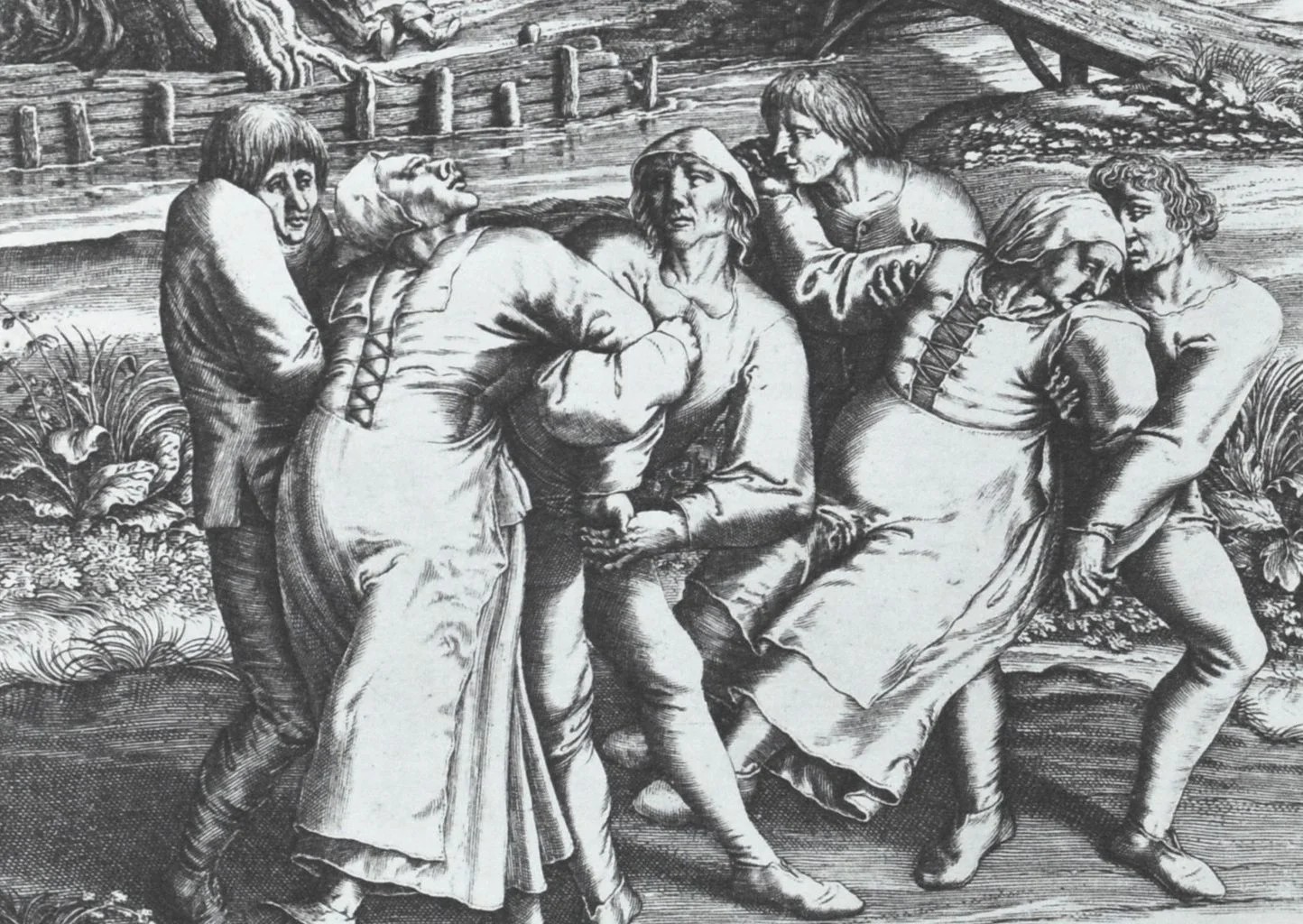Let’s dive into the intriguing world of dance disease! Picture this: You’re watching a dancer on stage, and suddenly their movements become erratic and strange. What’s going on? Welcome to the captivating world of dance disease, where movement and illness collide. We’ll explore how dance can reveal mysteries about the human body, and how dance-inspired treatments can help people with certain illnesses move with more grace and confidence.
Unveiling the Dance Disease: A Curious Intersection of Art and Science
Have you ever wondered why people dance uncontrollably without music or reason? It’s not just a groovy party trick; it’s a neurological condition called dance disease.
Imagine having your body do the Electric Slide on its own, without you even trying! That’s what it’s like. Chorea, for example, makes your hands and feet jiggle like you’re a puppet in a comedy sketch.
Dancing Mania: The Historical Hoedown
Long ago, people believed that dance disease was caused by demons or overheated blood. But nowadays, we know it can be all about a funky fungus on rye bread called ergot. This little bugger releases chemicals that can make your brain do the rumba!
Getting to the Root of the Matter
Today, we can treat dance disease with medicines, therapy, and even a little bit of lifestyle jazz. It’s like giving your body a dance instructor to help it get its groove back.
But Hold Up… Dance as a Cure?
Here’s a twist: dance can also be a way to get better! For people with dance disease, special dance classes can help them feel less stiff, walk taller, and be more social. It’s like taking Zumba but with a neurological twist.
The Dance of Life
Dance disease is a reminder that even when our bodies do the unexpected, we can find joy and expression in the strangest of places. Like any challenge, it can be both a hurdle and an opportunity to dance through life with resilience and creativity.
Discover the captivating tale of the dancing plague of 1518, a bizarre historical event where people danced uncontrollably for days. Explore the fascinating details of this mass hysteria and its mass hysteria cases.
What is the history of dance disease and what are some famous examples?
Picture this: Imagine people dancing uncontrollably, their bodies swaying and twitching like puppets on a string. That’s called dance disease or dancing mania, and it’s a fascinating chapter in the history of medicine.
Unveiling the History of Dance Disease
For centuries, civilizations have witnessed this peculiar phenomenon. It’s like a strange dance party where the participants can’t help but move their bodies in bizarre ways. And guess what? It can affect anyone, from single individuals to entire crowds.
Famous Outbreaks of Dance Disease
Some of the most notable outbreaks of dance disease include:
- The Dancing Plague of 1518: This dance-off took place in Strasbourg, France. Yep, we’re talking about hundreds of people dancing like crazy for days on end. It was so intense that some poor souls even danced themselves to death!
- Tarantism: In Southern Italy, people believed that the bite of the tarantula spider was behind this dancing frenzy. They’d perform elaborate dance rituals to ward off the imaginary spider venom.
Dance Disease: A Mysterious Puzzle
Throughout history, people have had different explanations for dance disease. Some thought it was possession by evil spirits, while others blamed it on natural forces or even cosmic influences.
Modern Understanding of Dance Disease
Today, we know better. Dance disease is actually a group of neurological conditions that affect the brain and cause involuntary movements. These movements can range from simple twitching to full-blown dance-a-thons.
Managing Dance Disease
If you or someone you know is experiencing dance disease, there are ways to manage it. Medications, therapy, and lifestyle changes can help control the symptoms and improve overall well-being.
So, there you have it, a brief history of dance disease. It’s a fascinating and sometimes bizarre phenomenon that continues to intrigue scientists and historians alike.
Are there any psychological or social factors that contribute to dance disease?
Ever heard of the phrase “Dance like no one’s watching”? Well, it turns out that doing exactly that can have some pretty positive effects on our minds and bodies.
Psychological Benefits of Dancing:
- Sharpens your brain: Dancing requires you to coordinate your movements, which stimulates your cognitive functions. It’s like giving your brain a workout!
- Boosts your mood: Moving to the beat can release endorphins, which are those feel-good hormones. So, if you’re feeling a little down, put on some music and let loose.
- Builds your self-esteem: When you’re dancing, you’re expressing yourself in a way that’s unique to you. This can help you feel more confident and comfortable in your own skin.
Social Advantages of Dancing:
- Connects you with people: Dance brings people together. Whether it’s in a class, a dance party, or a performance, it’s a great way to meet new people and connect with others who share your passion.
- Reduces isolation: Dancing can be a way to combat loneliness and isolation. When you’re dancing, you’re surrounded by people who are enjoying the same thing you are.
- Improves your confidence: When you dance in front of a crowd, it can be a confidence booster. It’s a chance to let go of your inhibitions and express yourself freely.
The Dance-Body-Mind Connection:
Dance isn’t just about moving your body; it’s about expressing yourself, connecting with others, and boosting your well-being. It’s a true mind-body-soul experience that can leave you feeling energized, happy, and confident. So, whether you’re a seasoned dancer or just starting out, embrace the power of dance and let it enhance your life in more ways than one.
What treatments are available for dance disease and what is the prognosis?
If you’re struggling with uncontrollable movements, slurred speech, or other symptoms of dance disease, you’re not alone. Millions of people around the world are affected by this condition, and while there’s no cure, there are treatments that can help you manage your symptoms and live a fulfilling life.
Medications
Medications can be used to control the involuntary movements associated with dance disease. These medications work by targeting the neurotransmitters in your brain that are responsible for these movements.
Physical Therapy
Physical therapy can help improve your coordination and balance. This is especially important if you’re having difficulty walking or performing other everyday activities. Physical therapy can also help you strengthen your muscles and improve your range of motion.
Speech Therapy
Speech therapy can help you improve your speech if you’re having difficulty speaking clearly. This is especially important if you’re having trouble communicating with others. Speech therapy can teach you how to use your voice more effectively and how to control your breathing.
Occupational Therapy
Occupational therapy can help you learn how to perform daily activities more easily. This can include things like eating, dressing, and bathing. Occupational therapy can also help you find adaptive equipment that can make it easier to do these activities.
Surgery
Surgery is sometimes an option to treat dance disease if other treatments haven’t been successful. Surgery can be used to remove a damaged or malfunctioning part of the brain that’s causing the symptoms of dance disease.
The Prognosis
The prognosis for dance disease depends on the type and severity of the disease. Some types of dance disease respond well to treatment, while others may be more difficult to manage. In some cases, dance disease can lead to disability.
It’s important to remember that dance disease is a complex condition, and the best way to manage it is to work with a team of healthcare professionals. This team can help you determine the best treatment plan for your individual needs and help you live a full and active life.
Key Takeaways
- Treatments for dance disease include medications, physical therapy, speech therapy, occupational therapy, and surgery.
- The prognosis for dance disease depends on the type and severity of the disease.
- Working with a team of healthcare professionals can help you manage your symptoms and live a full and active life.
FAQ
Q1: What is dance disease?
A1: Dance disease refers to neurological disorders characterized by involuntary dance-like movements, such as chorea and dancing mania.
Q2: What are the characteristics of chorea?
A2: Chorea is characterized by excessive, spontaneous, and irregular movements that are not repetitive and occur randomly.
Q3: What is the connection between dance and neurological disorders?
A3: Dance interventions have been found to positively impact individuals with neurological disorders like Parkinson’s disease, enhancing their motor skills and overall well-being.
Q4: What historical event is known as the “dancing plague”?
A4: The dancing plague of 1518 in Strasbourg, France, is a well-known example of a social phenomenon where large groups of people danced uncontrollably for several weeks, sometimes resulting in exhaustion and death.
Q5: What are some theories about the causes of dancing mania?
A5: Modern investigations suggest that the consumption of rye flour contaminated with ergot, a fungus that contains hallucinogenic compounds, may have contributed to the dancing plague.
- Darren Centinello: The Untold Story of Elizabeth Pipko’s Husband and Political Strategist - November 22, 2024
- Discover Francesville, Indiana: A Small Town with a Big Heart and Rich History - November 22, 2024
- Findlay Community Mourns the Loss of Educator Eden Lasley After Tragic Train Accident - November 22, 2024
















